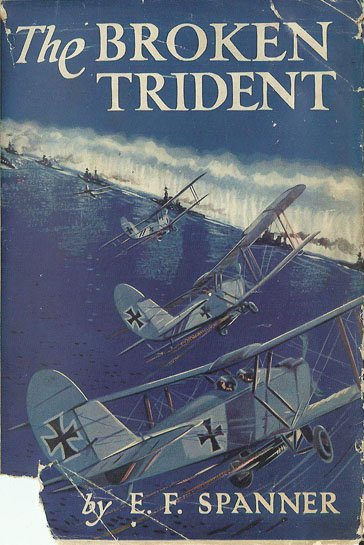Just before the outbreak of the First World War, a curious book was published in New York under the title The Secrets of the German War Office. The author, Dr. Armgaard Karl Graves, is described on the front cover as a 'Secret Agent'.1 He probably wasn't a doctor and his name was probably something else, but he was a German spy. Recruited in 1911 by German naval intelligence to gather information about Royal Navy activities off the Scottish coast, Graves was arrested on espionage charges in Glasgow in April 1912, convicted in July and sentenced to 18 months' imprisonment under the Official Secrets Act. He served only a few months of his sentence before being recruited by MO5 (the predecessor of MI5) to hunt down other German spies in Britain. But he managed to fool, defraud and finally escape his new masters. By February 1913 he was in New York; the following year he started telling the American press what he knew about both the British and the German intelligence services, along with some things he didn't know. The Secrets of the German War Office (ghostwritten by Edward Lyell Fox) came out just before war broke out, and sold very well.2
One chapter which would have been of particular interest was devoted to what Graves calls 'The most efficient and elaborate system ever devised by the ingenuity of man', namely 'the German War Machine'.3 It was here, in a section simply entitled 'Aërial', that he claims that a German airship had flown over Britain in peacetime, just as had been claimed by the British press and, in secret discussions, by the First Lord of the Admiralty in late 1912 and early 1913:
It is a far cry from Lilienthal's glider to the last word in aërial construction such as the mysterious Zeppelin-Parseval sky monster that, carrying a complement of twenty-five men and twelve tons of explosives, sailed across the North Sea, circled over London, and returned to Germany. Lilienthal's glider kept aloft four minutes, but this new dreadnaught [sic] of Germany's flying navy was aloft ninety-six hours, maintaining a speed of thirty-eight miles an hour, this even in the face of a storm pressure of almost eighty meters.4
That's all Graves says about peacetime airship flights over Britain. He doesn't give a date for this trip, but it would seem to have taken place in 1912. That could fit the Sheerness incident in October of that year, though an earlier date might fit better (he had last been in Germany in January or February 1913, in between Britain and the United States, so he could not plausibly have had access to secret information after then, but on his own account he was working for the British at that time). Of course, Sheerness is not London, but perhaps the airship flew there after passing over the coast. The figures given for the airship's performance are too high for this period, though. The speed is about right, though probably not in a storm; the naval airship L2 was carrying 28 people when it exploded near Berlin in October 1913. But no airship flew for such a long duration as claimed here until L59 in 1917 (the famous Africa flight), and in 1912 the most extra weight a Zeppelin could carry was about 9 tons. Most glaringly of all, there was never any such thing as a 'Zeppelin-Parseval' airship. The design philosophies of the two companies were utterly different, anyway: one built giant rigid airships, the other small non-rigid airships (even the propellors required centripetal force for stiffness). All in all, Graves's account seems dubious.
This pattern of mixing a little plausible fact with a lot of unlikely fiction recurs throughout The Secrets of the German War Office. For example, Graves describes attending alliance talks in the Black Forest between Winston Churchill, Richard Haldane and their German and Austrian counterparts in October 1911: this never happened, though Haldane did travel to Germany in February 1912 to try to negotiate an end to the naval arms race.5 In his 'Aërial' section, Graves makes equally absurd claims. He describes how Germany possesses three times as many airships as officially admitted, with the secret ones built using new technologies which make them far safer than the public ones:
The power of the ordinary hydrogen gas in all its various forms has been multiplied threefold by a new dioxygen gas discovered at the Spandau government chemical laboratory. This gas has also the enormous advantages of being absolutely noninflammable. I have seen experiments made with it. It cannot be used for illuminating purposes. Dirigibles that are equipped with it are not liable to the awful explosions that have characterized flights under the ordinary system. The new gas has also the enormous advantage of having a liquid form. To produce the gas it is only necessary to let the ordinary atmosphere come in contact with the liquid. Carried in cylinders two feet long and with a diameter of six inches it is obvious that enough of this liquid can be carried aboard the big war dirigibles to permit their refilling in midair. So, you see, all the objections to the commonly known system of operation have been overcome by the War Office.6
There is not and cannot be such a gas. Hydrogen is the lightest gas possible, since it consists of a single proton and electron. Anything else is going to be heavier. (Well, apart from a vacuum or plasma airship, anyway.) Since he calls this gas 'dioxygen', Graves implies that it has two oxygen atoms in it, making it about 32 times heavier than hydrogen. More to the point, it would be slightly heavier than air and would so would provide no lift at all. But perhaps he was misinformed, and actually meant helium, which of course is routinely used in airships today. He does say the secret gas is noninflammable, after all; and helium was first liquified in 1908. But helium, while very light, does not provide more lift than hydrogen but slightly less. Helium is rare and expensive, and no airships are known to have used it before 1921.
In the end, there's no reason to accept any of Graves's startling claims at face value. He was a fraud before he was a spy, and he was a fraud after he was a spy. He told MO5 what they wanted to hear about the existence of an extensive German espionage network in Britain in order to get out of jail; he told the American press the same in order to make a living. Not everything he said was made up; after all, he had been recruited as a spy by two countries and he had some true things to say. But as far as aviation is concerned, he revealed nothing that wasn't already known, and everything else was a farrago. As for the 'Zeppelin-Parseval' flight over London, since he was in Britain during the opening stages of the phantom airship scare, it's far more likely that his (or his ghostwriter's) inspirations were the very press reports about Zeppelins over Sheerness we started with, than any secret information he might have obtained during his brief return to Germany. So there's still no good evidence for any real Zeppelin flights to Britain before the war.
![]() This work is licensed under a Creative Commons Attribution-NonCommercial-NoDerivatives 4.0 International License.
Permissions beyond the scope of this license may be available at http://airminded.org/copyright/.
This work is licensed under a Creative Commons Attribution-NonCommercial-NoDerivatives 4.0 International License.
Permissions beyond the scope of this license may be available at http://airminded.org/copyright/.
- Armgaard Karl Graves, The Secrets of the German War Office (New York: A. L. Burt, 1914). [↩]
- For details of Graves's career, see Thomas Boghardt, Spies of the Kaiser: German Covert Operations in Great Britain During the First World War Era (Basingstoke and New York: Palgrave Macmillan, 2004), 60-3. [↩]
- Graves, The Secrets of the German War Office, 219. [↩]
- Ibid., 238. [↩]
- Ibid., chapter 8. [↩]
- Ibid., 241-2. [↩]




JDK
Fascinating stuff, particularly joining the dots and the Welcome collection bit. Definitely plot thickening.
Brett Holman
Post authorYes, I thought the Wellcome link shed some interesting light on his methods. Boghardt thinks that Graves was probably recruited by the Germans from prison as well. A professional fraudster might seem an ideal candidate for espionage, I suppose; but it seems he thought his talents were not sufficiently appreciated, financially speaking...